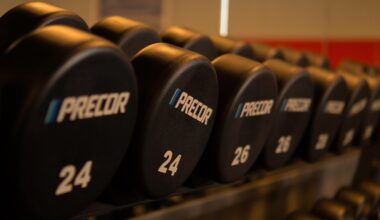Maximize Muscle Growth with Fall Strength Routines
As the leaves change color and temperatures drop, the fall season presents a unique opportunity to enhance your fitness regimen. Focused strength programs this autumn can boost your muscle growth while preparing for the winter months. Prioritize compound exercises, which work multiple muscle groups simultaneously, effectively building strength. Incorporate deadlifts, squats, and bench presses into your routine, ensuring balanced development across the body. Additionally, consider the benefits of resistance training bands, particularly for isolating smaller muscles. Lifting heavier weights isn’t always necessary; proper form should be the focal point for optimal results. Further enhance your training by refining your nutrition. A high-protein diet supports muscle recovery and growth, which is essential during this season. Aim to increase your protein intake through lean meats, legumes, and dairy products. Moreover, don’t forget about the importance of hydration, as it plays a significant role in overall performance. As temperatures drop, your body needs sufficient water to function efficiently. Keep track of your progress and adjust your workouts accordingly as you advance throughout the season. Consistency will be key in maximizing your fall strength gains.
Preparation is vital to ensure you’re following an effective fitness regime this fall. Before diving into your workout, consider setting specific, measurable goals. For muscle growth, aim to increase your weightlifting capacity gradually. Implement a progressive overload strategy, adjusting your weights as your strength improves. Incorporate variations of your primary lifts to engage different muscle fibers. Remember, the key to long-term success involves mixing your workout routine. Integrating new exercises prevents boredom and plates, which stunts growth. Bodyweight exercises can also be great supplements to your strength training. Push-ups, pull-ups, and lunges can be performed almost anywhere, offering functional strength improvement. Designing a balanced weekly routine can be key to success. Consider dividing your week into push, pull, and leg days. Strengthening your core is another critical component that should not be overlooked. Add planks, Russian twists, and leg raises to your routine to support overall stability. Enjoy your workouts and stay motivated by tracking progress visually or through workout logs. Focus on ensuring that your strength programs support your overall wellness and fun, transforming fitness into a fulfilling lifestyle.
Layer Your Workout Attire
With the arrival of cooler weather, layering your workout clothing becomes essential for comfort. Choosing moisture-wicking and breathable materials can help keep you warm and dry. Start with a fitted base layer that allows sweat to evaporate, followed by insulating layers such as fleece for warmth. Consider a lightweight, water-resistant outer layer to protect against wind and rain. Your choice of footwear is equally crucial; opt for shoes designed for supportive movement while providing sufficient traction for outdoor workouts. Fall activities like hiking and running on trails can diversify your training and engage muscles differently. Embrace the beauty of nature during your workouts by exploring local parks or trails. If you’re training indoors, create an inspiring environment. Elevate your workouts by adding personal touches that enhance motivation. Invest in essential gear like resistance bands, weights, or kettlebells to challenge your body effectively. Combining outdoor and structured gym workouts offers a comprehensive approach to your fall fitness goals. Attend local fitness classes or group sessions for added accountability and social support, which can supercharge your motivation to stick to your planned regimes.
Nutrition during the fall season should cater to your active lifestyle, especially if you’re engaged in vigorous strength training. As outdoor veggies come into harvest, focus on incorporating seasonal foods into your diet. Pumpkins, squashes, and sweet potatoes are nutrient-dense and contain necessary vitamins for muscle recovery. Including healthy fats from sources like nuts and avocados can enhance your overall caloric intake. Focus on consuming balanced meals throughout the day to sustain energy levels. Pre-workout snacks may include oatmeal or yogurt to fuel your performance. Post-workout, aim for a meal rich in protein and carbohydrates to replenish energy stores while facilitating recovery. Join meal prep workshops or seek online resources to help streamline your dietary habits. Additionally, staying on top of your vitamin D levels during the fall can be imperative, as reduced sunlight exposure can impact mood and energy. Don’t hesitate to consult a healthcare professional if you’re unsure about any dietary changes. The proper balance of nutrition and training coupled with rest days will give your body the momentum it needs to thrive this autumn.
Embrace Outdoor Activities
As temperatures drop, don’t underestimate the benefits of engaging in outdoor activities alongside your strength program. Autumn offers a plethora of opportunities for outdoor workouts, such as hiking and cycling. Not only do these activities boost cardiovascular health, but they can also aid significantly in muscle development. Consider joining a local running club or participating in weekend adventure races to maintain an active social life while pursuing fitness. Mixing in recreational sports, like flag football or soccer, can also provide a fun way to challenge your muscles differently, broadening your coverage of fitness activities. The dynamic movement from playing sports showcases agility and coordination, crucial for overall physical development. Aim to intersperse outdoor workouts throughout your weekly routine, encouraging consumption of fresh air and engagement with different environments. Additionally, pay attention to local seasonal events that encourage physical activity and community participation. This approach aids in maintaining motivation levels while enhancing your overall muscle-building routine. Remember, the varying landscape of the fall can showcase beautiful surroundings while keeping workouts fresh and exciting, contributing to a well-rounded fitness journey.
Recovery must be at the forefront of your fall training plan. Adequate recovery strengthens muscles and prevents overtraining associated injuries. After extensive strength workouts or outings, give your body the time needed to recover effectively. Incorporating active recovery sessions, such as yoga or light cardio, can help alleviate soreness and retain muscle flexibility. Having a solid stretching routine pre-and post-workout is equally essential to maintain mobility. Massage therapy or foam rolling sessions can also alleviate tightness accumulated from consistent training and enhance muscle recovery. Focus on proper sleep hygiene practices, as quality rest is a critical component of your recovery strategy. Aim for 7-9 hours of sleep each night to ensure your body repairs. Establish a bedtime routine to signal the body for rest and relaxation. Track your body’s response to different workouts and adjust your training intensity based on how you feel. A well-rounded approach promoting recovery will not only support muscle growth but also provide better performance in the long run. Establishing these habits may yield significant benefits to ensure a sustainable training program during your fall strength regimen.
Stay Motivated
Keeping your motivation levels high can significantly affect your strength training progress this fall. Consider setting realistic and achievable short-term goals to track progress throughout the season. Sharing your fitness journey with friends or social media can provide that extra layer of support and accountability. Creating a vision board showcasing your strength milestones can be a visual reminder of your ambitions. Reward yourself as you accomplish set targets, treating yourself to fitness gear or a refreshing outing. Another way to stay motivated involves varying your routine, as mentioned earlier. Schedule bi-weekly evaluations of your workouts. By recording gains, you’ll witness tangible achievements, fostering morale. This strategic approach can keep you driven, preventing monotony in your regime. Engaging in friendly competitions or challenges with workout buddies can inject excitement into your training sessions. Finally, remember that fitness is a journey, and progress takes time. Celebrate small victories and maintain a positive mindset through any challenges you face along the way. Ongoing motivation will not only support your muscle growth but also provide valuable life lessons that extend beyond just physical conditioning.
Autumn is a transitional season that symbolizes change, providing an ideal backdrop for personal growth through fall strength programs. Embrace these seasonal challenges as a means to reflect on your achievements and potential for improvement. Rethink your training perspective by considering the reasons why you began this journey in the first place. Engage in self-care practices, nurturing the relationship you have with your body through fitness. Seek opportunities to learn new skills, whether in strength training or nutrition, to maximize your growth potential. Remaining open to new experiences fosters an adaptable mindset that will help you overcome hurdles along the way. In the process, you’ll build resilience and confidence as you push your physical limits, laying the groundwork for a healthier lifestyle. Make a conscious effort to connect with nature by exercising outdoors amidst the vibrant fall foliage. Use this time to reflect on goals, aspirations, and adjustments necessary for optimal performance. Ultimately, embrace this autumnal chapter as a chance to invest in yourself. Stay committed to achieving your fall strength objectives, and you’ll undoubtedly reap the rewards as the season unfolds.


